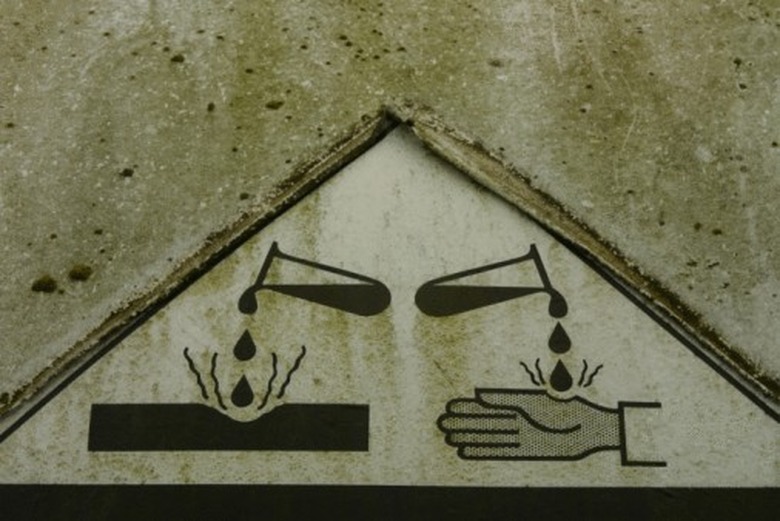Common Acid Base Indicators
Acid and base indicators are used in chemistry to determine a substance's pH. They change to different colors depending on whether they are added to an acid, a base or a neutral substance. Most indicators are themselves weak acids and respond to changes in the hydrogen ion concentration.
pH Scale and Acid and Base Indicators
pH Scale and
Acid and Base Indicators
The pH range functions between 0 to 14 with 7 being neutral. A pH above 7 indicates a base, and those below 7 indicate an acid. The pH scale is logarithmic, and with each individual number change on the scale, there is a ten-fold change in acidity of alkalinity (basicity).
Acid and base indicators are sensitive to the change of pH, or, more specifically, to the change in the concentration of hydrogen ions, H+, in solution.
Most acid and base indicators are large organic molecules that contain alternating double and single carbon-to-carbon bonds. In basic solutions, the acid and base indicators become ions by losing hydrogen ions from their chemical composition, usually from an OH group. This changes the structure of the molecule, causing indicators to absorb light at different wavelengths and change colors.
Types of Indicators
Types of
Indicators
Many types of indicators work throughout the pH scale. It is important to choose one that falls within the pH range under consideration. Several common indicators are given below.
Litmus Paper
Litmus Paper
One common acid and base indicator is litmus paper created by treating filter paper with a dye obtained from lichens. A solution applied to litmus paper will either keep the litmus the same color or change it.
Red litmus is a weak diprotic acid; it can donate two hydrogen atoms. Below pH 4.5, a red litmus paper stays red, but turns blue in a base. Above pH 8.3, a blue litmus paper stays blue but turns red in an acid.
The litmus indicator is not able to determine a pH value, only to distinguish between acids and bases. Neutral litmus paper is purple.
Phenolphthalein Indicator
Phenolphthalein Indicator
The phenolphthalein indicator is a weak acid that has two different structures based on whether it is in an alkali (pink) or acid (colorless) solution. The alkali solution absorbs light in the visible light spectrum, and the human eye perceives a color change to pink at pH level of 8.2, continuing to bright magenta at pH 10 and above.
Phenolphthalein is commonly used as an indicator in acid-base titration experiments in the chemical laboratory. A solution of known concentration is carefully added into one of unknown concentration and the phenolphthalein indicator. When the solution turns from colorless to pink (or vice versa), the titration or neutralization point has been reached, and the unknown concentration may be calculated.
Bromothymol Blue Indicator
Bromothymol Blue Indicator
Bromothymol blue, a weak acid, is most commonly used as an indicator for solutions that are relatively neutral —weak acids and bases. Its pH range is between 6 and 7.6. The solution appears yellow up to pH 6, in a neutral solution it is green, and it turns blue in basic solutions above pH 7.6.
In the laboratory, bromothymol blue is often used as a biological slide stain, for testing photosynthesis and can be used to test the pH of swimming pools.
Methyl Red Indicator
Methyl Red Indicator
As an acid and base indicator, methyl red turns red in acidic solutions at pH 4.4 and below and turns yellow when pH 6.2 is reached. In between these color endpoints, in the pH range 4.4 to 6.2, the color is orange.
Methyl red may be used as an acid and base indicator in the laboratory and as an azo dye, the largest group of synthetic **dyes,** commonly used to treat textiles.
Universal Indicator
Universal
Indicator
A universal indicator is a solution that contains a mixture of indicators, often phenolphthalein, methyl red and bromothymol blue. Identification of an approximate pH is obtained by adding several drops of a universal indicator to a solution.
Red indicates a strong acid, in the range of pH 1 to 4, while a weak acid has an orange hue. In a neutral solution, the color turns yellow-green. Purple indicates a strong base, above pH 11, while weak bases exhibit a bluish tint.
Cite This Article
MLA
Kozlowski, Rosann. "Common Acid Base Indicators" sciencing.com, https://www.sciencing.com/common-acid-base-indicators-8375206/. 1 March 2020.
APA
Kozlowski, Rosann. (2020, March 1). Common Acid Base Indicators. sciencing.com. Retrieved from https://www.sciencing.com/common-acid-base-indicators-8375206/
Chicago
Kozlowski, Rosann. Common Acid Base Indicators last modified March 24, 2022. https://www.sciencing.com/common-acid-base-indicators-8375206/
